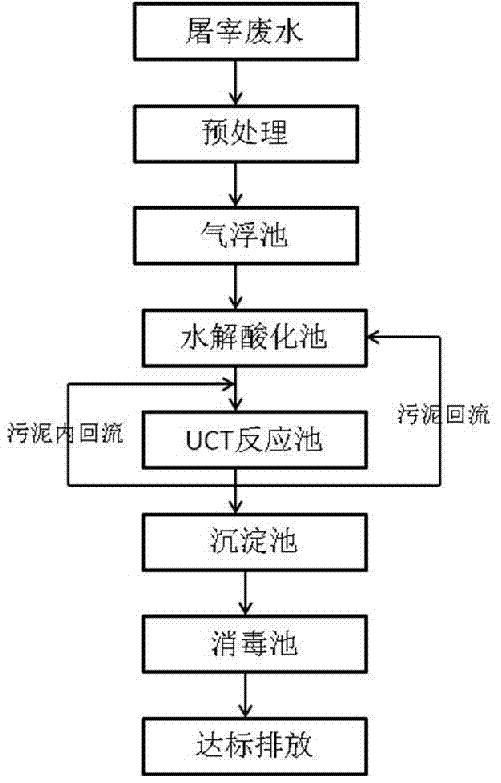Process for treating slaughtering wastewater by using UCT
A technology for slaughtering wastewater and processes, applied in the fields of filtration treatment, sedimentation treatment, water treatment parameter control, etc., can solve the problems of water pollution, complicated operation, unstable operation, etc., and achieve the effect of reducing sludge treatment costs and stabilizing the removal rate.
- Summary
- Abstract
- Description
- Claims
- Application Information
AI Technical Summary
Problems solved by technology
Method used
Image
Examples
Embodiment Construction
[0023] In order to make the object, technical solution and advantages of the present invention clearer, the present invention will be further described in detail below in conjunction with the accompanying drawings and embodiments. It should be understood that the specific embodiments described here are only used to explain the present invention, not to limit the present invention.
[0024] The present invention is implemented in Fenggang Slaughterhouse of Xiamen Chengyuan Food Co., Ltd., and the waste water of the slaughterhouse in this embodiment is 500 m of waste water per day. 3 , Table 1 is the water quality before wastewater treatment:
[0025] refer to figure 1 , a kind of technology that adopts UCT to process slaughtering waste water, comprises the following steps:
[0026] 1) Pretreatment: Slaughter waste water passes through the grid and micro-filter to remove large suspended matter and large solid matter, enters the grease trap to remove grease and impurities, and...
PUM
 Login to View More
Login to View More Abstract
Description
Claims
Application Information
 Login to View More
Login to View More - R&D
- Intellectual Property
- Life Sciences
- Materials
- Tech Scout
- Unparalleled Data Quality
- Higher Quality Content
- 60% Fewer Hallucinations
Browse by: Latest US Patents, China's latest patents, Technical Efficacy Thesaurus, Application Domain, Technology Topic, Popular Technical Reports.
© 2025 PatSnap. All rights reserved.Legal|Privacy policy|Modern Slavery Act Transparency Statement|Sitemap|About US| Contact US: help@patsnap.com



